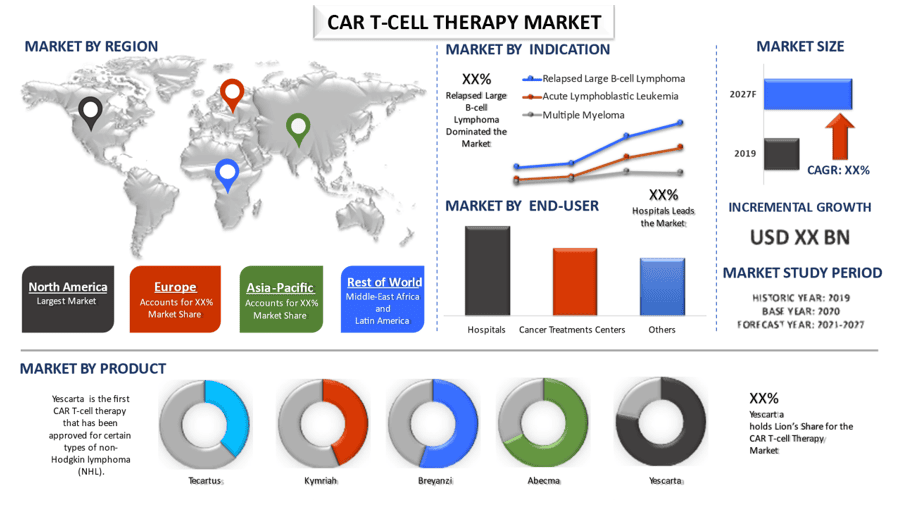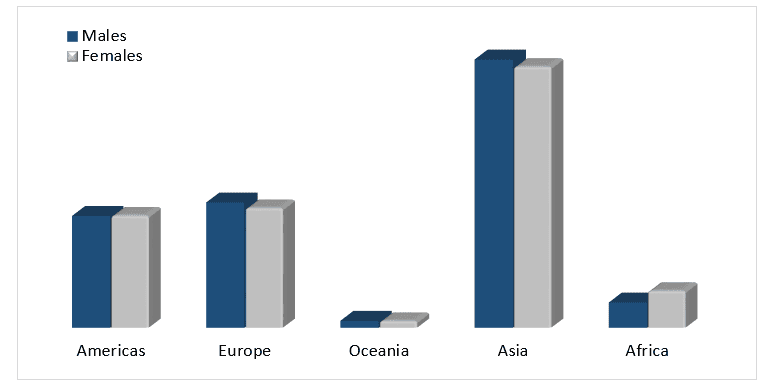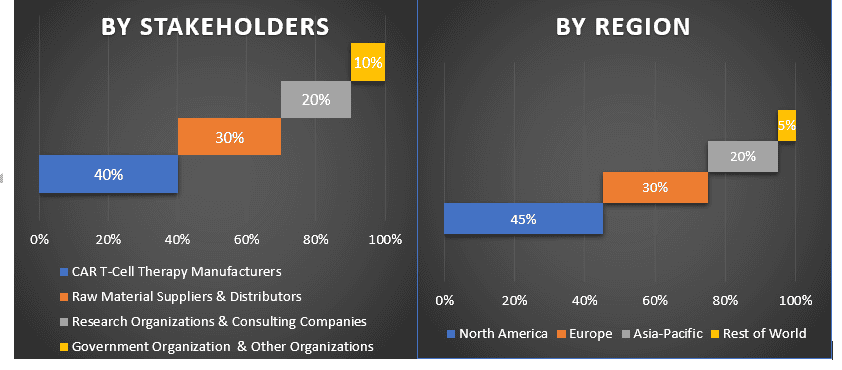Рынок CAR T-клеточной терапии: текущий анализ и прогноз (2021-2027)
Акцент на продукте (Abecma, Breyanzi, Kymriah, Tecartus, Yescarta); Показания (Рецидивирующая крупноклеточная B-клеточная лимфома, Острый лимфобластный лейкоз, Множественная миелома); Конечные пользователи (Больницы, Центры лечения рака и другие); Регион/Страна

ЗАПРОСИТЬ БЕСПЛАТНЫЙ ОБРАЗЕЦ PDF
Ожидается, что глобальный рынок CAR T-клеточной терапии будет расти с экспоненциальным среднегодовым темпом роста в течение прогнозируемого периода (2021-2027 гг.). CAR T-клеточная терапия — это вид иммунотерапии, который считается революционным методом лечения рака. При этой терапии Т-клетки берутся из крови пациента и модифицируются в лаборатории для атаки на раковые клетки. CAR T-клеточная терапия чаще всего используется для лечения некоторых видов рака крови и изучается для лечения других типов рака.
Растущее внедрение CAR T-клеточной терапии можно объяснить ростом заболеваемости раком в сочетании с быстро растущим стареющим населением. По данным Организации Объединенных Наций, численность населения старше 60 лет в 2017 году составила 962 миллиона человек, что более чем вдвое превышает показатель 1980 года, составлявший 382 миллиона человек. Ожидается, что к 2050 году число пожилых людей снова удвоится и достигнет почти 2,1 миллиарда во всем мире. Кроме того, по оценкам CDC, число случаев рака в США будет увеличиваться на 49% каждый год, с 1 534 500 в 2015 году до 2 286 300 в 2050 году, причем наибольший процентный рост наблюдается среди взрослых в возрасте ≥75 лет. Этот экспоненциальный рост распространенности рака во всем мире вызвал ажиотаж среди различных фармацевтических компаний в отношении инвестиций в разработку новых и эффективных методов лечения рака. Тем самым стимулируя рост рынка CAR T-клеточной терапии.
Кроме того, ожидается, что рынок CAR T-клеточной терапии будет расти за счет растущего технологического прогресса, большого количества текущих исследовательских работ в этой области, увеличения государственных и частно-государственных инвестиций, огромного конвейера CAR T-клеток и увеличения числа одобрений FDA. Например, в феврале 2022 года FDA одобрило carvykti, новый индивидуальный клеточный метод лечения от Johnson & Johnson, для лечения множественной миеломы. Однако некоторые ограничения на рынке, включая коммерческие модели с высокой степенью вовлеченности и побочные эффекты, связанные с CAR T-клеточной терапией, сдерживают рост этого рынка во всем мире.
Распределение заболеваемости раком в мире (%), 2020 г., по полу

Novartis AG, Gilead Sciences, Inc., Amgen, Inc., Juno Therapeutics, Eli Lilly and Company, Sorrento Therapeutics, Fate Therapeutics, Inc., Johnson & Johnson, Celgene Corporation, Bluebird bio, Inc., являются одними из выдающихся игроков, работающих на рынке CAR T-клеточной терапии. Несколько слияний и поглощений, а также партнерств были предприняты этими игроками, чтобы предоставить клиентам CAR T-клеточную терапию.
Аналитические выводы, представленные в отчете
«Среди продуктов, сегмент yescarta занимает основную долю»
На основе продукта рынок CAR T-клеточной терапии сегментирован на abecma, breyanzi, Kymriah, tecartus и yescarta. Сегмент yescarta занимал значительную долю рынка в 2020 году, и по оценкам, он будет быстро расти в течение прогнозируемого периода. Yescarta — это первая CAR T-клеточная терапия, одобренная для определенных типов неходжкинской лимфомы (НХЛ). Рост этого сегмента можно объяснить индивидуальной настройкой каждой дозы yescarta, поскольку лечение создается с использованием иммунной системы пациента для борьбы с лимфомой.
«Среди показаний сегмент рецидивирующей крупноклеточной В-клеточной лимфомы занимает основную долю»
На основе показаний рынок CAR T-клеточной терапии делится на рецидивирующую крупноклеточную В-клеточную лимфому, острый лимфобластный лейкоз (ОЛЛ) и множественную миелому. Сегмент рецидивирующей крупноклеточной В-клеточной лимфомы занимал основную долю рынка CAR T-клеточной терапии в 2020 году, и ожидается, что в ближайшие годы он будет расти со значительным среднегодовым темпом роста. Рост этого сегмента связан с ростом заболеваемости рецидивирующей крупноклеточной В-клеточной лимфомой и увеличением числа одобрений FDA CAR T-клеточной терапии для той же.
«Среди конечных пользователей сегмент больниц занимает основную долю»
На основе конечных пользователей рынок фрагментирован на больницы, центры лечения рака и другие. В 2020 году сегмент больниц захватил значительную долю рынка, и ожидается, что в течение прогнозируемого периода он будет расти со значительным среднегодовым темпом роста из-за увеличения числа больниц в различных странах с развивающейся экономикой, улучшения инфраструктуры и доступности различных медицинских услуг в больницах, что приводит к растущим предпочтениям пациентов в отношении лечения в больничных условиях. Тем не менее, центры лечения рака также, вероятно, станут свидетелями самого быстрого роста в течение прогнозируемого периода.
«Северная Америка представляет собой один из крупнейших рынков рынка CAR T-клеточной терапии»
Для лучшего понимания динамики рынка CAR T-клеточной терапии был проведен подробный анализ различных регионов по всему миру, включая Северную Америку (США, Канада и остальная часть Северной Америки), Европу (Германия, Франция, Испания, Великобритания, Италия и остальная часть Европы), Азиатско-Тихоокеанский регион (Китай, Индия, Австралия, Япония и остальная часть АТР), остальная часть мира. Северная Америка составляет основной рынок индустрии CAR T-клеточной терапии и принесла доход в размере XX миллионов долларов США в 2020 году благодаря развитой инфраструктуре здравоохранения и растущему внедрению CAR T-клеточной терапии в регионе.
Причины купить этот отчет:
- Исследование включает анализ определения размера рынка и прогнозирования, подтвержденный проверенными ключевыми экспертами отрасли
- В отчете представлен краткий обзор общих показателей отрасли с первого взгляда
- Отчет охватывает углубленный анализ выдающихся коллег по отрасли с основным акцентом на ключевые финансовые показатели бизнеса, портфель продуктов, стратегии расширения и последние разработки
- Подробное изучение движущих сил, ограничений, ключевых тенденций и возможностей, преобладающих в отрасли
- Исследование всесторонне охватывает рынок по различным сегментам
- Глубокий анализ отрасли на уровне региона
Варианты настройки:
Глобальный рынок CAR T-клеточной терапии может быть дополнительно настроен в соответствии с требованиями или любым другим сегментом рынка. Кроме того, UMI понимает, что у вас могут быть свои собственные потребности бизнеса, поэтому не стесняйтесь обращаться к нам, чтобы получить отчет, который полностью соответствует вашим требованиям.
Содержание
Анализ исторического рынка, оценка текущего рынка и прогнозирование будущего рынка глобального рынка CAR T-клеточной терапии были тремя основными шагами, предпринятыми для создания и анализа внедрения CAR T-клеточной терапии в основных регионах мира. Были проведены исчерпывающие вторичные исследования для сбора исторических данных о рынке и оценки текущего размера рынка. Во-вторых, для подтверждения этих выводов было принято во внимание множество результатов и предположений. Кроме того, были проведены исчерпывающие первичные интервью с отраслевыми экспертами по всей цепочке создания стоимости глобального рынка CAR T-клеточной терапии. После предположений и подтверждения рыночных показателей посредством первичных интервью мы использовали подход "сверху вниз/снизу вверх" для прогнозирования полного размера рынка. После этого были приняты методы разбивки рынка и триангуляции данных для оценки и анализа размера рынка сегментов и подсегментов, к которым относится отрасль. Подробная методология описана ниже:
Узнать больше о методологии исследования
Анализ исторического размера рынка
Шаг 1: Углубленное изучение вторичных источников:
Было проведено подробное вторичное исследование для получения исторических данных о размере рынка CAR T-клеточной терапии из внутренних источников компании, таких как годовой отчет и финансовая отчетность, презентации результатов деятельности, пресс-релизы и т. д., и внешних источников, включая журналы, новости и статьи, правительственные публикации, публикации конкурентов, отраслевые отчеты, сторонние базы данных и другие надежные публикации.
Шаг 2: Сегментация рынка:
После получения исторических данных о размере рынка CAR T-клеточной терапии мы провели подробный вторичный анализ для сбора исторических рыночных данных и доли для различных сегментов и подсегментов для основных регионов. Основные сегменты, включенные в отчет, включают продукт, показания и конечных пользователей. Был проведен дальнейший анализ на уровне стран для оценки общего внедрения CAR T-клеточной терапии во всем мире.
Шаг 3: Факторный анализ:
После получения исторических данных о размере рынка различных сегментов и подсегментов мы провели подробный факторный анализ для оценки текущего размера рынка CAR T-клеточной терапии. Кроме того, мы провели факторный анализ с использованием зависимых и независимых переменных, таких как растущий прогресс в технологиях и увеличение распространенности рака. Был проведен тщательный анализ сценариев спроса и предложения с учетом ведущих партнерств, слияний и поглощений, расширения бизнеса и запуска продуктов в секторе CAR T-клеточной терапии во всем мире.
ЗАПРОСИТЬ ИНДИВИДУАЛЬНУЮ НАСТРОЙКУ
Оценка и прогноз текущего размера рынка
Определение текущего размера рынка: На основе практически применимых результатов, полученных на основе вышеуказанных 3 шагов, мы определили текущий размер рынка, ключевых игроков на рынке CAR T-клеточной терапии и доли рынка сегментов. Все необходимые процентные доли и разбивки рынка были определены с использованием вышеупомянутого вторичного подхода и проверены посредством первичных интервью.
Оценка и прогнозирование: Для оценки и прогнозирования рынка различным факторам, включая движущие силы и тенденции, ограничения и возможности, доступные для заинтересованных сторон, были присвоены веса. После анализа этих факторов были применены соответствующие методы прогнозирования, т.е. подход "сверху вниз/снизу вверх", чтобы получить прогноз рынка примерно на 2027 год для различных сегментов и подсегментов на основных рынках мира. Методология исследования, принятая для оценки размера рынка, включает:
- Размер рынка отрасли в стоимостном выражении (доллары США) и уровень внедрения CAR T-клеточной терапии на основных рынках страны
- Все процентные доли, разбивки и разбивки рыночных сегментов и подсегментов
- Ключевые игроки на рынке CAR T-клеточной терапии с точки зрения предлагаемых продуктов. Кроме того, стратегии роста, принятые этими игроками для конкуренции на быстрорастущем рынке
Подтверждение размера и доли рынка
Первичное исследование: Были проведены углубленные интервью с ключевыми лидерами мнений (KOL), включая руководителей высшего звена (CXO/вице-президенты, руководители отдела продаж, руководители отдела маркетинга, руководители оперативного отдела и региональные руководители, руководители стран и т. д.) в основных регионах. Затем результаты первичных исследований были обобщены, и был проведен статистический анализ для доказательства заявленной гипотезы. Данные, полученные в результате первичных исследований, были объединены с вторичными данными, что позволило превратить информацию в действенные выводы.
Распределение первичных участников по различным регионам

Инжиниринг рынка
Метод триангуляции данных был использован для завершения общей оценки рынка и получения точных статистических данных по каждому сегменту и подсегменту рынка CAR T-клеточной терапии. Данные были разделены на несколько сегментов и подсегментов после изучения различных параметров и тенденций в областях продуктов, показаний и конечных пользователей рынка CAR T-клеточной терапии.
Основная цель исследования рынка CAR T-клеточной терапии
В исследовании были точно определены текущие и будущие рыночные тенденции CAR T-клеточной терапии. Инвесторы могут получить стратегические сведения, на которых они могут основывать свое усмотрение для инвестиций, на основе качественного и количественного анализа, проведенного в исследовании. Текущие и будущие рыночные тенденции определили общую привлекательность рынка на региональном уровне, предоставляя промышленному участнику платформу для использования неиспользованного рынка, чтобы извлечь выгоду в качестве преимущества первопроходца. Другие количественные цели исследований включают:
- Анализ текущего и прогнозируемого размера рынка CAR T-клеточной терапии в стоимостном выражении (доллары США). Кроме того, анализ текущего и прогнозируемого размера рынка различных сегментов и подсегментов
- Сегменты в исследовании включают области продуктов, показаний и конечных пользователей
- Определение и анализ нормативно-правовой базы для индустрии CAR T-клеточной терапии
- Анализ цепочки создания стоимости с участием различных посредников, а также анализ поведения клиентов и конкурентов в отрасли
- Анализ текущего и прогнозируемого размера рынка CAR T-клеточной терапии для основного региона
- Основные регионы, изученные в отчете, включают Северную Америку, Европу, Азиатско-Тихоокеанский регион и остальной мир
- Профили компаний рынка CAR T-клеточной терапии и стратегии роста, принятые участниками рынка для поддержания устойчивости на быстрорастущем рынке
Углубленный анализ отрасли на региональном уровне
Связанные Отчеты
Клиенты, купившие этот товар, также купили










